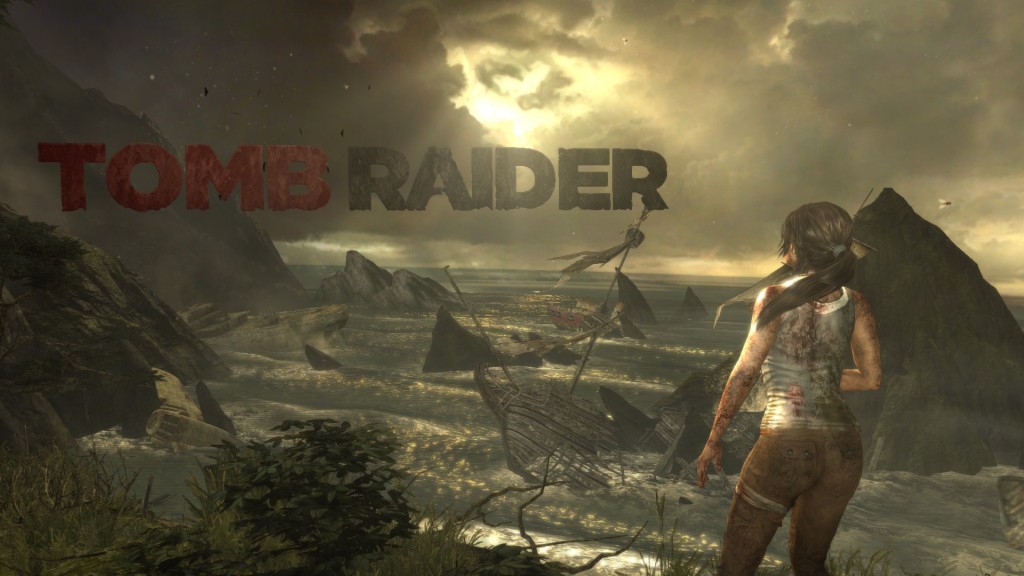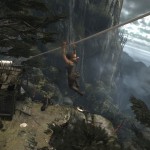- Tomb Raider: More brain & less brawn, please
- Tomb Raider – The Very Quick Verdict (and a reflection on cover shooting)
For the last week, I’ve guided Lara Croft across an island filled with dangers, both natural and two-legged, in Tomb Raider. This is the first game in the series I’ve played (apart from the Guardian of Light spinoff) – after developer Crystal Dynamics promised both lavish AAA excitement and a story with a heart, I hoped for something truly great. Halfway in, I can report this is good, and often exciting – but so far, it’s not great.

Tomb Raider is structured a little like the 2008 Prince of Persia – it consists of a linear sequence of plot-driven tasks, interspersed with the ability to go back and explore previously cleared areas. Plot sequences play out as a combination of 3D platforming, scripted set-pieces, and third-person cover shooting, while exploration is more freeform and emphasises platforming and puzzle-solving.
For a fictitious example, the story might require Lara to reach a supply cache on a remote cliff. So Lara would begin by scrambling up several rock faces to approach the cliff. Upon approaching the cliff, she might shelter from two chit-chatting sentries, then silently pick them off with her bow. She might filch the supplies, find a shotgun inside… only to run for her life as the cliff begins to crumble beneath her feet. On her way back, an enemy patrol might jump her in a scripted sequence, giving her an opportunity to use the newly found shotgun. Finally safe again, she would have a new story objective… but if she went back to explore, she might be able to open up a previously closed room with a judicious blast from her new shotgun.
The thing about Tomb Raider is that some of these gameplay elements are better than others. In fact, Tomb Raider is really two games in one:

1. A very good platformer and “brainy” game, emphasising exploration, athletics, and – when enemies appear – stealth.
Tomb Raider is best when it plays to its strengths. This is a game in which it’s rewarding to think one’s way through a problem, whether it’s working out the best way to stealthily dispatch a group of enemies, or solving a puzzle so Lara can escape from a room where she’s trapped. It is also a game that, like Prince of Persia and Assassin’s Creed, takes joy in motion, and Lara controls even better than Altair and Ezio. Even where there is no puzzle to be solved, it is a pleasure to hop across village rooftops, or from cliff to cliff; and exploration brings a nice reward, in the form of collectibles that flesh out the game’s backstory. (Game designers take note: this is how to implement optional collectibles. Documents and items that add texture to the world, plot, and characters, yes; feathers randomly scattered around Renaissance Italy, no.)
Interestingly, I find that reflexes are not that important for this part of the game. I am terrible at timing jumps (that sound you hear is Chell, Sackboy, and the Prince groaning in pain), but I’ve not had any frustration with the platforming, and especially with the more freeform, aspects of Tomb Raider. So far, even the puzzles have relied less on dexterity and more on working out the right solution.

2. A generic “brawny” cover shooter.
Unfortunately, the further I get into the game, the more shootouts Lara finds herself in – and the bigger, more bombastic, and less thoughtful they become. Think Lara wielding an assault rifle against what feels like an entire platoon of grenade-chucking, zipline-riding, SMG-wielding psychos. New enemies will keep spawning in waves, and Lara can only proceed once she’s killed them all. Stealth? What stealth? This is not when Tomb Raider plays to its strengths.
By that, I don’t mean that the shootouts are terrible. The controls are fine (even with a gamepad), and the cover system works well – Lara automatically moves in/out of cover without my needing to press a button; I’ve never gotten killed due to inadvertently moving out of cover; etc. Rather, the problem is that as a cover shooter, Tomb Raider feels rote. Hide behind barrier, shoot; when enemy flanks or lobs grenade, move to the next barrier; shoot; repeat. There’s little room for player ingenuity or “interesting decisions”, in contrast to the puzzle and stealth action segments (or, for that matter, more imaginative shooters such as Deus Ex: Human Revolution, whose uneven firefights challenged me to use every special power I had). And yet, it’s these increasingly repetitive blam-blam segments that Tomb Raider keeps throwing my way.
As such, Tomb Raider’s mechanics betray confusion about what the game wants to be. Is this the subtle tale of a young woman using her wits to survive? Or is it a summer blockbuster, long on explosions and short on brains? The game’s opening hours, and the more freeform sections, suggest the former; the section where I am suggests the latter. The former is what the game does best; the latter… well, like the stereotypical summer blockbuster, the excitement wears off.
That said, I am only partway through the game. I’m sure I have hours left to go before I finish Tomb Raider, and to be honest, the prospect thrills me less than it did at the start of the game. Still, I would like to finish; and we’ll see if Lara can regain her momentum.

Discover more from Matchsticks for my Eyes
Subscribe to get the latest posts sent to your email.






2 thoughts on “Tomb Raider: More brain & less brawn, please”